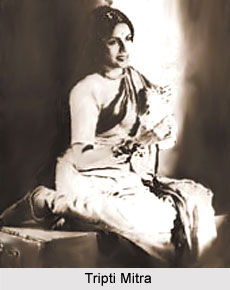 Tripti Mitra was a popular name in the history of contemporary Bengali theatre. She first acted in her cousin Bijon Bhattacharya`s play Agun or `Fire` in 1943. she soon became a member of the Indian People`s Theatre Association and acted in its productions of Bhattacharya`s Jabanbandi or `Testimonial` and Nabanna or `New Harvest` in the following year. She married Sombhu Mitra who was co-director of Nabanna in 1945 and left IPTA in 1947 to join his group Bohurupee, formed in 1948. She also entered Hindi movies, essaying intense tragic performances as the low-caste rural heroine in Mahesh Kaul`s Gopinath i.e. `Gopi`s Lord` in 1948, and later as the boy hero`s widowed mother in Khwaja Ahmad Abbas`s Munna in 1954.
Tripti Mitra was a popular name in the history of contemporary Bengali theatre. She first acted in her cousin Bijon Bhattacharya`s play Agun or `Fire` in 1943. she soon became a member of the Indian People`s Theatre Association and acted in its productions of Bhattacharya`s Jabanbandi or `Testimonial` and Nabanna or `New Harvest` in the following year. She married Sombhu Mitra who was co-director of Nabanna in 1945 and left IPTA in 1947 to join his group Bohurupee, formed in 1948. She also entered Hindi movies, essaying intense tragic performances as the low-caste rural heroine in Mahesh Kaul`s Gopinath i.e. `Gopi`s Lord` in 1948, and later as the boy hero`s widowed mother in Khwaja Ahmad Abbas`s Munna in 1954.
Her characterization of Phuljan, the starving Muslim peasant`s wife in Tulsi Lahiri`s Chhenra tar or `Snapped String` in 1950 won her immediate recognition on the stages of Bengali theatre as an actress of uncommon ability. Her reputation rose with her roles in the productions of Rabindranath Tagore`s Char adhyay or `Four Chapters` in 1951 and Raktakarabi or `Red Oleander` in 1954. For sheer virtuosity she was unrivalled. The variety of challenging parts she took ranged from the three queens in Tagore`s Bisarjan or Immersion`, Raja in 1964 and Sophocles`s Raja Oedipus in 1964, to the two cornered victims of male prejudice in Tendulkar`s Chop, adalat chalchhe or `Silence! The Courts in Session` in 1971 and Nitish Sen`s Aparajita in 1971. In Badal Sircar`s Baki itihas or `Remaining History` in 1967 she played variations of two different characters and in Aparajita her monologue held audiences in thrall for two hours.
Tripti Mitra`s portrayals were more than just convincing. Many had the stamp of truly artistic creations. Her acting and stage presence arrested spectators through the coordinated movements of her supple body. Her expressive face which caught and reflected the subtle and shifting mental states of people, her deep understanding of characters, the astonishing scale and use of her voice, and her ability to establish a rapport with viewers all were of unique style. Although a product of the `new drama movement`, she showed she could also mesmerize the mixed and less discriminating audience of professional theatre when she joined Biswaroopa to take the lead role in Setu or `Bridge` in 1959. She acted in other commercial plays, too, without interrupting her work for Bohurupee. She finally ended her long association with Bohurupee in 1979, starting a training-cum-production group with younger persons, for whom she directed several plays.




















